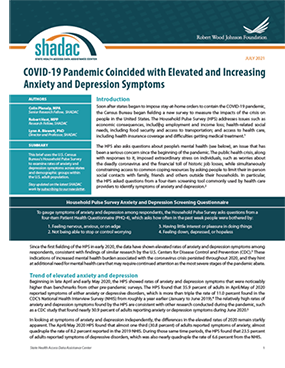Blog & News
New Study Shows Heightened Mental Health Burdens for Young Adults, Adults with Lower Incomes or Lower Education Levels, and Adults who Experienced Income Loss during the COVID Pandemic
July 1, 2021:As rates of COVID vaccination increase around the world and the nation, attention is beginning to turn toward addressing more of the non-physical impacts and effects of the virus, such as the mental health burdens borne by large segments of the population.1
 In a new issue brief released this week, SHADAC researchers used the U.S. Census Bureau’s Household Pulse Survey to study the relationship between the COVID-19 pandemic and mental health burdens for the United States’ adult population. Based on data gathered in April/May through December of 2020, the brief’s authors found that reported rates of combined and individual symptoms of anxiety and depression in the first part of the year were more than triple when compared with data from a similar time period in a related survey, the Center for Disease Control and Prevention’s (CDC) National Health Interview Survey (NHIS). The HPS found a rate of 35.9 percent of adults reporting anxiety or depression symptoms in April/May 2020, versus 11.0 percent from the NHIS in January-June 2019.2 And rates only continued to grow significantly throughout the remainder of 2020, reaching a peak of 41.9 percent in December.
In a new issue brief released this week, SHADAC researchers used the U.S. Census Bureau’s Household Pulse Survey to study the relationship between the COVID-19 pandemic and mental health burdens for the United States’ adult population. Based on data gathered in April/May through December of 2020, the brief’s authors found that reported rates of combined and individual symptoms of anxiety and depression in the first part of the year were more than triple when compared with data from a similar time period in a related survey, the Center for Disease Control and Prevention’s (CDC) National Health Interview Survey (NHIS). The HPS found a rate of 35.9 percent of adults reporting anxiety or depression symptoms in April/May 2020, versus 11.0 percent from the NHIS in January-June 2019.2 And rates only continued to grow significantly throughout the remainder of 2020, reaching a peak of 41.9 percent in December.
In particular, the analysis found that the highest rates of these mental health burdens were borne by younger adults, adults with less than a high school education, adults with lower incomes, and adults who experienced or anticipated job-related income loss. In each case, reported rates of anxiety or depression symptoms were significantly higher than those for the total population (41.9 percent).
In December 2020…
…younger people consistently reported the highest rates of anxiety or depression, with more than half (56.4 percent) of 18-29 year-olds reporting symptoms of anxiety or depression, a significantly higher rate than this same group reported in April/May 2020.
…roughly one-half (51.2%) of adults with less than a high school education reported anxiety or depression symptoms.
…more than half (58.2 percent) of adults with household incomes of less than $25,000 reported anxiety or depressions symptoms, a statistically significant increase over their April/May 2020 rate.
The HPS also collected data on anxiety and depression symptoms from adults who had either experienced or anticipated a job-related income loss during the 2020 year. Just over one-half of individuals (53.2 percent) who had experienced an employment income loss reported symptoms of anxiety or depression, which was significantly higher than the roughly one-third (31.5 percent) rate among people who hadn’t experienced such a loss. An even greater number of people who anticipated an employment income loss (58.0 percent) reported anxiety or depression symptoms, which was again significantly higher than the approximately one-third (35.0 percent) rate among people who didn’t anticipate such a loss.
The pandemic's toll on mental health, especially for younger adults, has become increasingly worrisome in recent months.3 Mental health burdens, such as suicide deaths, were already an area of concern prior to COVID, with rates trending upward in the years before 2020.4
It is important for policymakers, as they consider directing resources toward addressing the impacts of COVID-19 on their individual populations, to understand which groups (i.e., younger adults, adults with lower incomes and education levels, and adults who experienced income losses) might benefit most from outreach to connect them with or increase their access to mental health care services.
Explore Additional COVID-related SHADAC Work Using the HPS
SHADAC previously wrote a blog post that provided an overview of the Household Pulse Survey (HPS) methodology as well as survey and questionnaire updates.
SHADAC has also used HPS data to track vaccination rates for a range of demographic groups, producing our own state-level estimates of vaccination rates for a biweekly blog series.
Additionally, SHADAC produced a blog studying vaccine hesitancy rates among adults during the first part of 2021.
1 Tully, T. (Updated 2021, June 11). Covid-19: U.S. Vaccine Production and Supply Increase After Snowstorms Caused Delays. The New York Times. https://www.nytimes.com/live/2021/02/23/world/covid-19-coronavirus
Soucheray, S. (2021, May 28). COVID-19 vaccinations increase in US, but unevenly. Center for Infectious Disease Research and Policy (CIDRAP). https://www.cidrap.umn.edu/news-perspective/2021/05/covid-19-vaccinations-increase-us-unevenly
Abbot, A. (February 2021). COVID’s mental-health toll: how scientists are tracking a surge in depression. Nature. https://www.nature.com/articles/d41586-021-00175-z
2 The pandemic-era rates from the CDC study and the HPS are not perfectly comparable to the pre-pandemic rates from the NHIS because they come from different surveys with different methodologies. However, since they ask essentially the same questions on anxiety and depression, the rates should presumably be similar, so the substantially higher estimates in the pandemic-era surveys provide reason for concern.
3 Fernandez, M.E. (2021, March 8). AHA News: COVID-19 Mental Health Crisis Is Hitting Young Adults. U.S. News & World Report. https://www.usnews.com/news/health-news/articles/2021-03-08/aha-news-covid-19-mental-health-crisis-is-hitting-young-adults
4 Planalp, C., Hest, R., & Au-Yeung, C. (June 2020). Suicide Rates on the Rise: National Trends and Demographics in Suicide Deaths from 2000 to 2018. State Health Access Data Assistance Center (SHADAC). https://www.shadac.org/sites/default/files/publications/2020_NATIONAL-Suicide-brief.pdf
Hill, R.M., Rufino, K., Kurian, S., Saxena, J., Saxena, K., & Williams, L. (March 2021). Suicide Ideation and Attempts in a Pediatric Emergency Department Before and During COVID-19. Pediatrics, 147(3), e2020029280; DOI: https://doi.org/10.1542/peds.2020-029280









